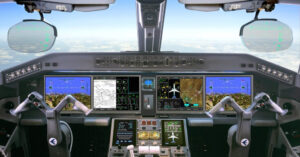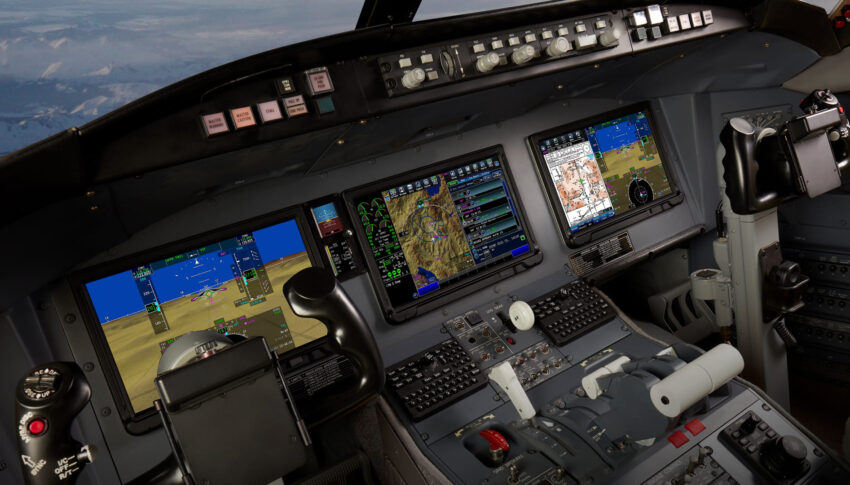Avionics systems are constantly being updated to help pilots operate aircraft more efficiently. Bernie Baldwin learns from two major providers the philosophy and the technologies behind such systems.
Everyone has a limit to the amount of information that they can absorb over a specific period of time. If too much comes at someone at once, some prioritisation needs to take place and it’s quite likely that something will be overlooked.
The modern aircraft cockpit is exactly the sort of place where such a situation might occur, with pilots having a plethora of data available to them. Managing that data as well as handling communications and performing all the necessary handling skills requires assistance from the cockpit avionics systems.
Thankfully, the suppliers of such specialist equipment are continually developing systems to aid the pilot workload. Jason Bialek, product line director, integrated avionics at Honeywell Aerospace Technologies, has been assessing the new avionics technologies and products that are likely to enter airline service in the near future, including the catalyst which makes them possible or appropriate for application in an aircraft programme.
“In the airline world, the ‘near future’ can sometimes be 5–10 years, so we’ll use that as the timeframe,” Bialek begins. “I expect we will see broader adoption of ATC through datalink, FANS [future air navigation systems] and satcom upgrades, SelCal 32 [selective-calling radio system], more connectivity supporting efficiency of operations and maintenance ops, and broader adoption for certain operators of LP/LPV [localiser performance/localiser performance with vertical guidance] approaches to regional airports.”

“Additionally, safety feature-wise, eventually large transport OEMs will accept how much safer it is for crews to fly with synthetic vision displays and start to introduce those into aircraft,” he asserts. “Finally, implementation of SURF-IA [Situational Awareness on the Airport Surface with Indications and Alerts] and ground collision and runway incursion prevention technologies will be accelerated.”
Collins Aerospace is another organisation always looking at new possibilities for cockpit avionics. Matt Mathias, the company’s associate director of avionics product marketing, gives his take on what might be coming down the technology pipeline. “The adoption of new and emerging commercial avionics technologies is constantly evolving, driven by the continual industry imperative to provide pilots improved cockpit connectivity, increased efficiency, advanced safety and enhanced operational performance,” he confirms.
“The growing demand for reliable and speedy inflight Wi-Fi goes beyond passenger entertainment purposes and is increasingly becoming a top priority at the nose of the aircraft. Real-time data transmission in the cockpit has entrails into everything from operational safety and pilot productivity to logistical support and flight planning,” Mathias emphasises. “As such, airframers are increasingly looking for emerging solutions that utilise advancements in satellite systems, low-earth-orbit constellations or datalink communications that offer the reliability and quicker connections necessary to handle the workload complexities associated with flying an aircraft safely.”
Mathias relates how Collins is intently focused on how it can take the best of these connectivity solutions and integrate their unique capabilities into the advanced flight deck operations for which the company is renowned — allowing greater pilot control and input over the central functions of the aircraft.
“We’re also seeing that innovations in cockpit displays and augmented reality (AR) systems have a profound impact on situational awareness, safety and operability. Large area flight deck displays, integrated head-up displays (HUD) and advanced vision systems provide pilots with critical, real-time flight information through every stage of flight — enabling more efficient routing and visual clarity in degraded weather conditions, giving pilots the information and agency to make important operational decisions,” Mathias adds.
“Our HUD technology integrates synthetic and enhanced vision systems in a single display, providing a clear view with heads-up and eyes-forward operations no matter the weather, lighting or time of day. The advanced functionality of Collins HUD systems not only provides clarity during the most critical stages of flight — including during takeoff, descent and landing sequences — but is also certified during times of low-visibility takeoff and landing. This maximises on-time performance and reduces operational costs associated with fuel burn resulting from multiple go-arounds or extended time runway taxiing.
“Aircraft avionics systems are also increasingly leveraging digital systems, including artificial intelligence (AI) and machine learning (ML) to enhance safety, efficiency and operational performance,” Mathias confirms. “It’s also important to note that not all of the many automated flight operations we currently see making their way into the cockpit are driven by AI or ML technologies. The term ‘automation’ is sometimes mistakenly interpreted as synonymous with ‘artificial intelligence’.
“While this is certainly true in some instances, rule-based automation implemented into flight systems is actually best achieved without AI, operating instead on a set of predefined algorithms to simplify pilot duties,” he remarks. “Examples of this include emergency procedures, automatic landing systems, traffic collision avoidance and traditional autopilot systems.”
Mathias does, however, see the implementation of AI technology into flight deck operations in a couple of distinct areas. “First, AI can be a powerful tool off the aircraft in the development, design and testing of the next generation of avionics products and solutions that will make their way onto the aircraft. Engineering and product development teams are increasingly implementing AI technologies into their workflows, creating developmental efficiencies and increased product reliability, accelerating the product development process and reducing customer lead times,” he explains.
“Secondly, we see future applications of AI in the flight deck as a tool to support human crews and the decision-making process. AI systems can help pilot decision-making in a number of ways, including navigating congested airspace, simplifying complex operations and even recognising pilot fatigue and drowsiness, alerting operators to the impact the operational workloads are creating for pilots and crews,” Mathias elaborates.
The Collins executive goes on to describe the company’s overall philosophy towards creating efficiency in the cockpit. “Automation and digitalisation are about continuous improvement in aviation safety and efficiency. Human flight crews are the foundational components in flight operations today and we fully expect they will remain responsible for the safety and operation of commercial flights in the future,” he declares. “That’s not to say the roles and responsibilities of pilots and crews won’t evolve with time and technology maturation, but at Collins we fully expect humans to remain the foundational decision-making component of critical flight operations.
“Our automation focus revolves around developing solutions that serve as decision support tools for human operators. Where can we simplify the complex and create brevity out of the sometimes-overwhelming amount of data flowing to a pilot in real-time? What systems and tools can we standardise to perform the tedious work of data analysis, aggregation and delineation? These are the digitalisation aides that simplify tasks for operators, allowing the machines — trained to handle, process and distil mountains of data into meaningful and actionable information for pilots and crews — to make the best decisions for their unique missions,” Mathias states unequivocally.
Discussing the Honeywell philosophy in this area, Jason Bialek argues that the best way to think about supporting airline customers by improving efficiency in the cockpit, is to focus on the frequency of certain tasks and the time those tasks take, or how disruptive it is when errors are made as those tasks are completed. “Sometimes, the task is completely local within the cockpit with no interaction with other teams off-board, but many of the tasks involve teams outside the cockpit,” he advises.
“Honeywell has been pushing recently to do everything that can be done to eliminate situations where flight crews are simply moving data. Every time a human tries to move information from one place to another, the potential for errors, delays, or other problems exists,” Bialek notes. “Our technology can eliminate or minimise the time needed for tasks not directly related to flying the aircraft or monitoring operations for threats or increasing risk, whether it’s approaching weather systems, problems with the aircraft, or any other challenge. When crews have more time to monitor and address these risks, airline operations become safer and more efficient.
“Digitalisation investments will continue to move the needle with respect to eliminating flight crew distractions, potential for errors, and any avoidable delays in other teams supporting those flight crews getting the information they need,” he opines. “Often, when implemented correctly, these improvements can save significant effort of one person’s time per flight. Substantial potential still exists for increasing cockpit efficiency, though.”
Like any major systems provider, Honeywell puts new or upgraded avionics products into service on a regular basis, both for line fitting and retrofits. In recent times, Bialek reports, these have included the company’s RDR-7000 weather radar, SmartView synthetic vision system (SVS), FANS and satcom updates, CMF [communication management function] upgrades, flight management system (FMS) upgrades like Pegasus and FMS 7.1 or NG-FMS, Smart Runway/Smart Landing, JetWave X, ADG-400 and connected offerings. These, plus Forge Flight Efficiency services, are all available now and provide a combined set of operational benefits and, in some cases, weight and power benefits.
Matt Mathias points to Collins Aerospace’s Pro Line Fusion integrated avionics system as the key product in the company’s avionics portfolio. The suite is the standard fit on the Airbus A220 family and has retrofit upgrades available on a number of business aircraft platforms, including the Global 5000/5500/6000/6500 series, Challenger 604, Citation CJ family of aircraft, Gulfstream 280, Embraer Legacy 450/500, Embraer Praetor 500/600 and the Beechcraft King Air.
“Fusion is our latest advanced flight deck, offering operators enhanced safety, reliability and more efficient operations,” Mathias mentions. “Fusion features stunning visual and tactile features, including large integrated touchscreen displays and an integrated FMS, allowing operators to see and intuitively touch what they want to change directly on the displays.
“Additional features include weather threat detection systems, integrated synthetic and enhanced vision systems, and an intuitive graphical interface. This enables heads-up and eyes-out operations in nearly all conditions,” he adds.
“Fusion also contains situational tools to enhance pilot decision making. Cockpit display of traffic information (CDTI) and airport moving maps (AMM) offer traffic and ground infrastructure information onto the forward displays, providing a clear view of traffic and the status of nearby aircraft, while mitigating an over-reliance on voice communication,” Mathias states in conclusion.
Creating efficiency in the way that pilots are able to handle information aids their performance. Honeywell, Collins and many others are delivering systems to ensure that nothing will be overlooked, especially the overall safety of the flight.
Author: Bernie Baldwin
Published: 1st August 2024



